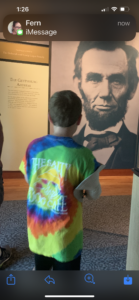 Why visit Gettysburg during blazing hot July?
Why visit Gettysburg during blazing hot July?
I did it mostly because my children and grandchildren and I were in the Washington, DC area last week for a family wedding. We’d rented a house only an hour’s drive from the battlefield, located in southern Pennsylvania near the Maryland state line. Gettysburg had been on my bucket list for a long time. Likewise for my ten-year-old grandson Eli, who loves all kinds of history, but especially anything to do with the Civil War.
He’d studied the battle in great detail and had memorized the opening paragraph of the Gettysburg Address, but I’m not sure anything could have prepared him (or any of the rest of us) for what we experienced that day. At the visitors’ center, we watched the 22-minute movie “A New Birth of Freedom,” narrated by Morgan Freeman. It was an excellent crash course about the battle, complete with music, lights and sound effects.
Then we moved into the round room that houses the Gettysburg Cyclorama, the largest oil-on-canvas painting in existence and one of only two cycloramas on public display in North America. The other is in Atlanta and depicts the Civil War battle that took place there in 1864. That cyclorama is a story unto itself. I don’t have room to write about it here, except to say that I saw it the 1960’s and have never forgotten that it portrayed the battle as a Confederate victory, which is absolutely untrue.
But back to Gettysburg. Its cyclorama depicts the story of Pickett’s Charge in horrifying detail. On July 3, 1863, after two days of fighting with neither side gaining advantage, 15,000 Confederate infantry troops charged through an open field toward Cemetery Ridge, where 6,500 Union troops were positioned. A bloodbath ensued, resulting in more than 6,000 Confederate casualties and the end of General Robert E. Lee’s ill-fated attempt to bring the war to the north. Most historians believe that if Gettysburg was the turning point of the Civil War, then Pickett’s Charge could rightly be called the decisive moment of the entire conflict.
We proceeded to the museum and then finished up the air-conditioned portion of our visit in the gift shop. All the expected items were for sale: books, t-shirts, coffee mugs, key chains, refrigerator magnets and on and on and on. But what drew my attention was the bin filled with “Billy Yank” and “Johnny Reb” soldiers’ caps. There was a time in my life–during the era when many folks in the south considered it okay to teach alternative facts about “The War of Northern Aggression”–when no one I knew would have considered buying anything but the gray cap. Where I came from, we never even play-acted being a Yankee.
Now I know better. I like to believe that most other Southerners do, too.
Those who don’t might ought to spend some time at Gettysburg, where “the butcher’s bill” was 23,000 Union Army soldiers and 27,000 Confederate soldiers killed, wounded or missing. Fifty thousand lives were ended or forever changed there, fighting about whether one race of human beings had a right to enslave another and whether eleven states that said yes to that question had a right to secede from the union.
On November 19, four months after the battle and with the Civil War still raging, President Abraham Lincoln—in only 271 words—summed up Gettysburg’s significance in one of the most famous speeches in history. “We here highly resolve that these dead shall not have died in vain,” he said. “This nation, under God, shall have a new birth of freedom and government of the people, by the people, for the people, shall not perish from the earth.”
That’s why Gettysburg was on Eli’s and my bucket lists. And it’s why it was extra-special to visit in the same sweltering month when the epic battle that helped preserve the United States of America took place.
(August 5, 2023)